Innovative Plant Scanning Apps for Care Insights
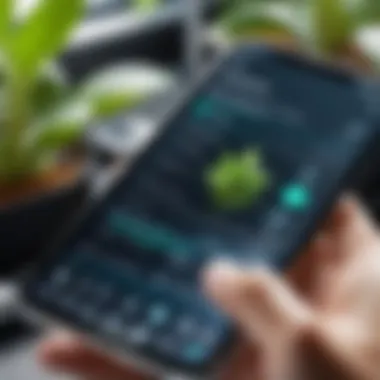
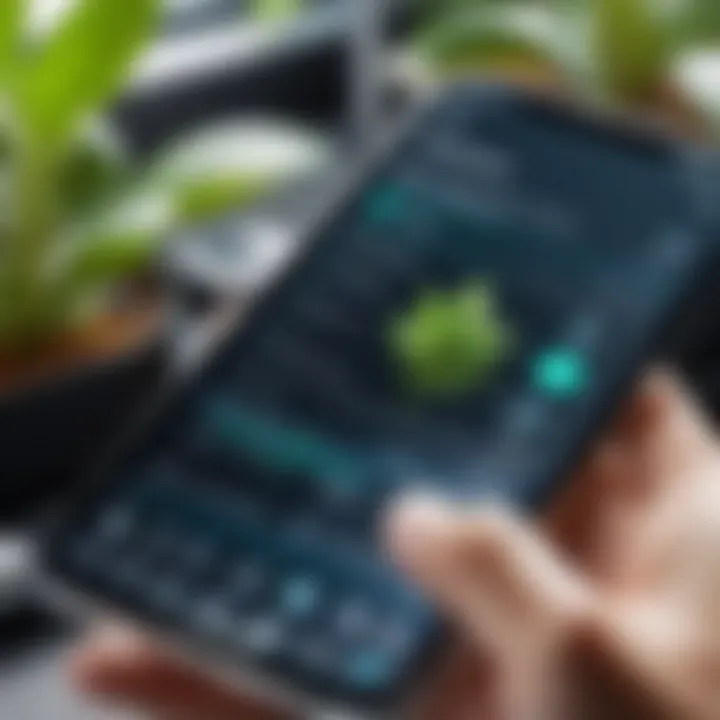
Intro
In today’s world, technology finds a way into every corner of our lives. Whether it's through smart appliances or apps that help manage our schedules, the tech wave is relentless. Among those advancements, plant care has seen a significant transformation, thanks to innovative applications specifically designed to scan and analyze plant health. This article will delve into how these plant scanning apps work, discuss their unique features, and explore their impact on plant care enthusiasts and casual plant owners alike.
Understanding what these apps bring to the table is vital, especially as more people find solace and joy in nurturing nature at home. As we explore the intersection of technology and plant care, expect to uncover detailed insights into the underlying technology, practical advantages, and the future landscape of plant management tools.
These apps do not just simplify the note-taking process or provide reminders about watering schedules; they provide a comprehensive look into the health of your plants, utilizing imaging and data to guide best practices. Get ready to dig deep into the world of plant scanning apps and how they’re pushing the envelope of traditional plant care practices.
Foreword to Plant Scanning Technology
In a world where technology intertwines seamlessly with everyday life, understanding plant care through innovative technologies emerges as a compelling topic. Plant scanning technology embodies a significant evolution in how individuals interact with their greenery. It allows not just for a basic connection to nature, but also facilitates deeper knowledge, smarter care routines, and effective problem-solving strategies for plant enthusiasts.
The Rise of Smart Gardening Solutions
The concept of smart gardening solutions marks a shift in attitude toward plant care. Gone are the days when growing plants relied solely on instinct and traditional knowledge passed down through generations. Nowadays, apps dedicated to plant scanning bring a technological edge that empowers users, especially those who might be new to the art of horticulture.
- Efficiency and Accuracy: Modern plant scanning apps utilize sophisticated algorithms to assess a plant's health status and identify its species. This technology reduces guesswork, making plant care more efficient.
- Accessibility of Information: Smart apps compile vast databases of plant information, making it readily accessible to users. Whether you're unsure if your pothos has root rot or looking to expand your collection, the right app can be a font of wisdom at your fingertips.
- Community Engagement: The rise of social media platforms and forums has fostered communities of plant lovers who share tips, troubleshooting advice, and personal stories, bridging the gap between technology and traditional plant care through collective knowledge.
It's clear that the fusion of technology and gardening opens up possibilities previously thought unattainable. This new wave invites a broader audience to participate in plant care while pushing seasoned enthusiasts to enhance their skills. As we delve into the functionality and benefits of plant scanning apps, the significance of this innovation becomes even more apparent.
How Plant Scanning Apps Function
The functioning of plant scanning apps is vital for both seasoned horticulturists and newcomers to the gardening scene. These applications utilize advanced technology to streamline the process of plant care, transforming it from a daunting task into a more manageable affair. At its core, understanding how these apps operate sheds light on their potential to revolutionize how individuals interact with their green companions.
Technological Framework
Image Recognition Algorithms
Image recognition algorithms are the backbone of plant scanning applications. They analyze photographs of plants, identifying species, and even assessing health conditions. One key characteristic of these algorithms is their ability to learn from vast datasets which enables them to improve recognition rates with time. For instance, the leafy greens in your garden can be instantly matched to a database of thousands of species.
What sets these algorithms apart is their unique capacity for continuous learning. They adapt to varying lighting conditions and differing leaf shapes, making them quite reliable. However, a downside exists; not every app has the same capacity for image processing, leading to potential inconsistencies depending on environmental factors.
Data Analytics for Plant Health
Data analytics plays a significant role in gauging plant health, allowing these apps to provide actionable insights. By collating various parameters, such as temperature, humidity, and light exposure, the algorithms can evaluate a plant's living conditions holistically. A defining feature of data analytics within these apps is their predictive capability; they don't just assess current health but suggest future care protocols based on gathered data.
Moreover, the strength of data analytics lies in its integrated reporting features. Users can track health metrics over time, which helps in recognizing patterns. However, this might overwhelm some users, especially those not as tech-savvy. So, it’s crucial that a balance between detail and simplicity is achieved.
User Interface and Experience
Intuitive Navigation
Intuitive navigation is another critical aspect of plant scanning apps. Without a straightforward user experience, even the most powerful technology can fall flat. An important characteristic of intuitive navigation is its focus on user-friendliness—the design should cater to a wide spectrum of users. Having clear pathways leads users to the tools they need without glitching their experience.
A strong feature here is the use of visual cues, like icons and guided prompts, which can ease the user into effectively utilizing the app. It’s like having a map in an unfamiliar city. However, if the navigation turns out to be too simplistic, it may limit more experienced users from accessing advanced features that could enhance their gardening prowess.
Customization Options
Customization options allow users to tailor their plant scanning experience, marking another essential aspect of these apps. Users value being able to personalize the app based on their preferences. This feature can range from changing notification settings for watering reminders to selecting specific plant types for tailored advice.
The flexibility afforded by customization can lead to a more engaged user base. People feel more in control and invested in their plant care when they can tweak various settings to suit their needs. The downside is that for users unfamiliar with technology, excessive options may create confusion, detracting from the core purpose of the app: to simplify plant care.
People are more likely to take care of plants when they feel in charge of their health journey—all thanks to the ease brought by technology!
As plant scanning apps progress, the framework by which they function keeps evolving, marrying cutting-edge technology with user-centered design. In the end, understanding their inner workings opens the door to a more fruitful and enlightened plant care experience.
Key Features of Plant Scanning Apps
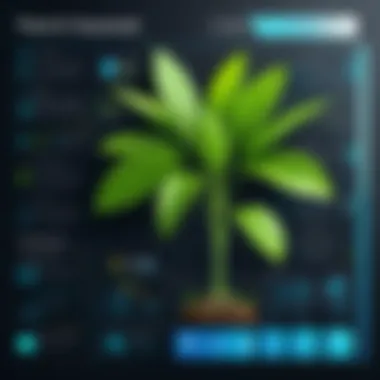
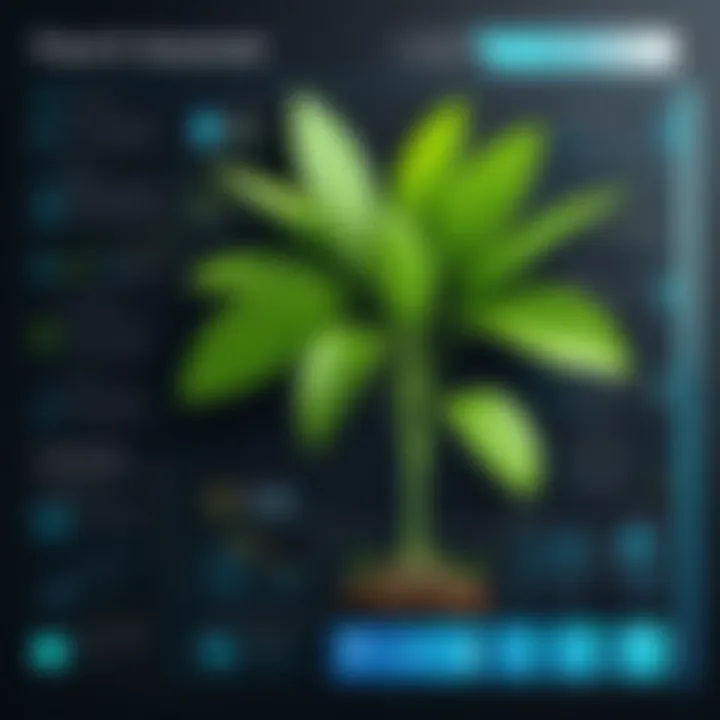
Understanding the core capabilities of plant scanning apps is fundamental for both casual plant lovers and dedicated horticulturists. These features not only amplify the users' comprehension of their plants' needs but also streamline the care process itself. It's akin to having a knowledgeable buddy right in your pocket, ready to dish out advice when you need it.
Plant Identification Capabilities
One standout feature of many plant scanning apps is their plant identification capability. When users snap a picture of a plant, the app quickly analyzes its characteristics using sophisticated image recognition algorithms. Most folks may not realize that, like people, plants have unique traits, and these tech marvels can discern the most minute differences between similar species.
Utilizing extensive databases, many of these apps can identify a wide range of plants, from common basil to rarer tropical specimens. This not only satisfies one's curiosity but also prevents accidental misidentification, which can be a frequent pitfall for enthusiasts. With accurate identification, users can ensure that they are providing the proper care and conditions for their plants.
Health Diagnosis and Recommendations
After identifying a plant, what's next? Here is where health diagnosis and recommendations come into play. Utilizing data analytics, certain apps can assess the health of a plant based on visual cues—think of leaf discoloration, wilting, or pest infestations. Users are often surprised by how much detail can get extracted from a simple photograph.
Apps like PlantSnap or PictureThis often provide insights, suggesting appropriate actions to remedy issues—ranging from watering schedules to identifying potential pests. This customized advice empowers users, turning a once daunting task into manageable steps. For someone just starting out or even for the seasoned gardener, such features bolster confidence in plant care.
Care Tracking and Notifications
Lastly, care tracking and notifications are indispensable tools offered by these scanning apps. Imagine receiving timely reminders for watering or feeding right when your plant needs it most. With a crowded modern life, it's easy to let such tasks slip through the cracks.
These apps can track individual plants' needs and alert users through notifications. Moreover, care logs help in understanding patterns—documenting how a plant thrived under specific circumstances might just be the key to replicating success later on. For the tech-savvy individual looking to optimize their gardening experience, this feature proves invaluable.
"The integration of technology in plant care has redefined the relationship between humans and their green companions. It's as if we’re entering a new garden where knowledge meets innovation."
With these pivotal features, plant scanning apps do more than just diagnose problems; they foster an ecosystem of engaged and informed plant care. As we venture deeper into their benefits and limitations, it's clear that these tools represent a significant shift in how we cultivate and nurture plants.
Benefits for Plant Enthusiasts
The journey of plant care can often feel overwhelming, especially for those new to gardening or plant ownership. Enter plant scanning apps, a potent combination of technology and gardening that has simplified the care of plants. These tools not only assist in nurturing plants but also enhance the overall experience for plant lovers. This segment dives into two significant aspects of how these apps benefit enthusiasts: enhanced knowledge and understanding, along with time and resource efficiency.
Enhanced Knowledge and Understanding
For many botany beginners, discerning the specific needs of different plants is like deciphering an ancient script. Plant scanning apps bridge this knowledge gap by providing detailed insights into plant species, care requirements, and even potential pests or diseases. Users can swiftly identify a plant by simply taking a snapshot. This capability eliminates the guesswork, empowering gardeners with critical information to make informed decisions regarding care.
The educational component of these apps can’t be overstated. They often contain a wealth of resources—practical articles, videos, and tips personalized to user’s plants. Imagine stumbling upon an unfamiliar plant and, within seconds, receiving notifications of its water needs or sunlight preferences. This immediacy enables gardeners to develop a deeper relationship with their greenery.
Moreover, the data collected over time provides a fuller picture. Users can track how their plants respond to different care techniques. Such capabilities not only foster a sense of accomplishment but can also spark a greater interest in botany. Ultimately, this knowledge helps cultivate not only healthier plants but also more informed enthusiasts.
Time and Resource Efficiency
Owning plants can be a labor of love, but maintaining them efficiently is key to enjoying the experience rather than finding it tedious. Plant scanning apps play a pivotal role in saving valuable time and resources in several ways.
First off, these applications can help potential pitfalls be avoided. For instance, if a user sees that their plant exhibits signs of a common issue, such as leaf discoloration due to overwatering, they can promptly adjust their care routine without wasting further time. This proactive approach not only saves time but also prevents the loss of plants that are often the result of preventable mistakes.
Furthermore, scrolling through rows of guidance articles or videos can consume ample time. Many apps streamline this process by consolidating care tips directly related to the specific plants users own. In just a few taps, users can access relevant resources that'll help them manage their greenery more effectively.
- Watering Reminders: Users can set notifications for when it's time to water or fertilize, preventing the all-too-common oversight of forgetting about their leafy companions.
- Growth Tracking: Some apps have features for tracking growth. This function allows for planning, permitting gardeners to allocate resources—like pots or nutrients—more wisely.
Embracing plant scanning technology ultimately liberates enthusiasts from unnecessary stressors, allowing them to focus on what matters: enjoying the beauty and tranquility that plants bring to their lives. In this way, technology and nature intertwine to make the experience richer and more fulfilling.
Limitations and Challenges
When delving into the realm of plant scanning apps, it’s essential to consider the limitations and challenges that accompany these technological advancements. While these applications offer remarkable capabilities for plant care, they are not without flaws that deserve attention. Understanding these challenges helps users set realistic expectations and might even prompt app developers to improve their technologies.
Accuracy and Reliability Issues
Environmental Factors
Environmental factors play a significant role in the accuracy of plant scanning apps. Conditions such as lighting, humidity, and temperature can greatly influence the way a plant's health is diagnosed. For instance, an app's image recognition algorithm may struggle in poor lighting, leading to inaccurate identification of a plant species or an incorrect diagnosis of its health status.
The variability of these external conditions emphasizes the necessity for accurate results; if a garden enthusiast scans a wilting plant under dim light, the app might inadvertently suggest over-watering as a solution, when in fact it might need more sunlight. It's a classic case of "garbage in, garbage out."
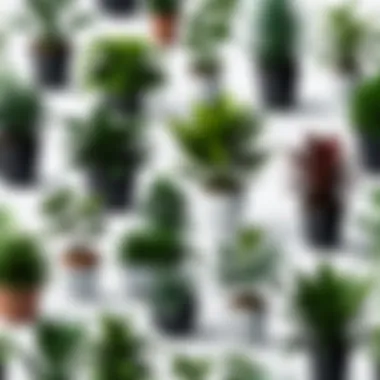
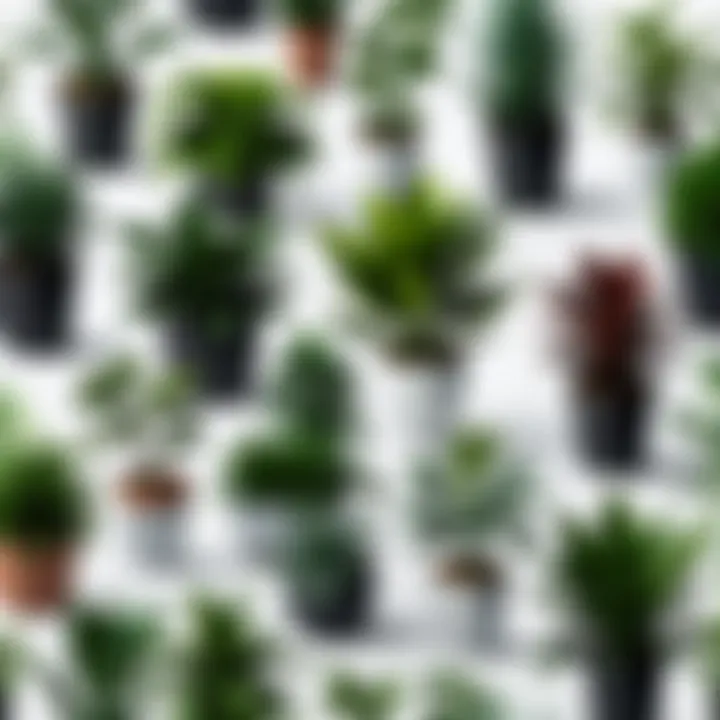
Key characteristics of environmental factors highlight both their unpredictability and their profound impact on the outcomes of plant health assessments. Without calibrated settings that consider these variables, users could end up with skewed data, raising questions about reliance on technology for something that demands nuance and attention to detail. The need for improved algorithms that can adapt to fluctuating environmental conditions is critical.
User Error
User error is another aspect that can significantly affect outcomes when utilizing plant scanning apps. Mistakenly scanning a leaf from an angle or not holding the camera steady can result in blurry images, misconstrued data, and ultimately, misguided care advice.
Many people often underestimate the importance of clear images and accurate scanning techniques. As a result, the app may recognize a plant incorrectly or misdiagnose its health. This introduces an element of human variability that cannot be overlooked. Users must take the time to learn the best practices for using these technologies effectively.
Understanding user error highlights that while technology can aid in plant care, it still requires engaged and informed users who are willing to adapt and learn. Each unique user interaction brings its own layer of advantage and disadvantage into the ecosystem of digital plant care, as users navigate between precision and inaccuracy.
Dependency on Technology
The dependency on technology presents a double-edged sword in the context of plant care apps. On one hand, these tools provide unprecedented access to information and support for modern horticulturists. On the other, relying too heavily on an app can detract from the deeper understanding of plant biology and care.
Gardeners might begin to prioritize app notifications over their personal observations, which can result in a disconnect from the natural world. Furthermore, in situations where technology fails—be it due to poor internet connectivity or software issues—gardeners could find themselves at a loss. The essence of gardening lies in the attunement to the needs of plants that sometimes cannot be captured merely by an app’s algorithm.
A balanced relationship between technology and traditional gardening knowledge is crucial. If reliance on technology overshadows the user’s intrinsic relationship with their plants, it can impede the ability to develop practical skills and intuitive responses to plant care.
In summary, while plant scanning apps have opened avenues for enhanced plant care, addressing their limitations and challenges is paramount for both users and developers alike. Understanding the intricacies involved lays the groundwork for future evolutions in this enticing junction of technology and horticulture.
Comparative Analysis of Available Apps
Comparing the various plant scanning apps is not just a matter of identifying what’s out there; it's about understanding which tools truly add value to plant care and how these apps can cater to the unique needs of plant enthusiasts. In a market bustling with options, such an analysis shines a light on different functionalities, pricing models, user experience, and overall effectiveness in promoting plant health. The insights gained from this comparison allow users to make informed decisions, enhancing their gardening journey without drowning in the sea of choices.
Market Leaders
When diving into the realm of plant scanning apps, a few key players consistently emerge as the go-tos for both seasoned gardeners and novice plant parents. PlantSnap and PictureThis hold substantial market share, thanks to their robust image recognition capabilities and extensive plant databases. They not only recognize thousands of species but also provide detailed care instructions. Users appreciate the speed with which these apps identify plants; an instant snapshot can lead to quick advice on how to nurture that beloved pothos or the delicate orchids perched on a windowsill.
While PlantSnap catches attention for its user-friendly interface, PictureThis steals the show with its augmented reality features, something that feels innovative and fresh. This capability makes gardening more interactive and allows users to visualize care tips right in their home environment—a small leap toward that smart home experience.
However, part of the appeal of these apps is not just their shiny features but also the vibrant communities they foster. Users share experiences and tips within platforms like Reddit, making the learning curve much less daunting.
Emerging Contenders
While the market leaders dominate, several emerging contenders are making waves, often at a more accessible price point or with specialized features. Apps like Gardenia focus on a community-driven approach, where users can input care notes, share updates on their plants, and even troubleshoot problems collectively. This sense of community resonates well with users who appreciate the support and shared passion.
Another noteworthy contender is SmartPlant, which targets urban dwellers living in limited spaces. Its focus on indoor plants is a boon for those in apartments who typically lack garden space. The app also incorporates seasonal reminders for care, ensuring you don’t forget to give your snake plant a little love—after all, life gets busy!
Furthermore, the introduction of apps like Floranote pushes the envelope even further, incorporating elements of gamification to engage users. This creative approach not only makes plant care a more enjoyable experience but also motivates users to stay involved with their greenery and track progress.
"The ability to connect with others who share the same passion for gardening, while leveraging the tools to enhance plant health, is what truly sets these emerging players apart!"
In essence, whether leaning toward established leaders or exploring fresh options, the importance of comparative analysis lies in its ability to help potential users evaluate their priorities—be it functionality, community engagement, or specialized features tailored to unique living situations. With technology underpinning these solutions, the journey toward mastering plant care continues to evolve.
Potential for Future Innovations
The role of technology in plant care is evolving, and the future looks promising for innovations in plant scanning applications. These developments have the potential to enhance user experience and provide more profound insights into plant care, making it easier for enthusiasts to thrive in their hobby.
Integration with Smart Home Systems
Integrating plant scanning apps with smart home systems is a significant step forward. Imagine being able to connect your plant care app with your home automation system. This integration could mean adjusting lighting conditions or watering schedules based on real-time data from the scanning app. For instance, if an app detects your Fiddle Leaf Fig isn’t receiving enough light, it could automatically communicate with your smart lighting to adjust the brightness. This seamless interaction not only simplifies plant care but also ensures optimal growth conditions.
"The right environment can make the difference between a healthy plant and one that struggles to survive."
The key benefits include convenience and efficiency. By utilizing data from plant apps, you can set routines that align with your plants’ needs, without constant manual adjustment. Moreover, this tech-savvy approach can help save you time, meaning less trial and error and more thriving greenery.
Advancements in AI and Machine Learning


Next up, advancements in AI and machine learning hold transformative potential. These technologies can improve the accuracy of plant health diagnostics dramatically. For instance, machine learning algorithms trained on vast datasets can identify patterns that may go unnoticed by the human eye. An algorithm could analyze factors like leaf shape, color variations, and soil moisture to provide tailored care recommendations.
One compelling aspect is the potential to predict diseases before they become visible. Using predictive analytics, if your app senses certain environmental conditions or physiological changes in your plants, it can alert you to potential threats like pests or nutrient deficiencies. This proactive approach enables plant owners to take action ahead of time, thus avoiding long-term damage to their green companions.
User Experiences and Reviews
User experiences and reviews play a pivotal role in shaping the perception and adoption of plant scanning apps. In a world where technological advancements continuously redefine our interactions with traditional practices, understanding user sentiments informs potential users about the advantages and pitfalls of these applications. As plant enthusiasts weigh their options, genuine feedback from those who have walked the path before can directly influence their choices. It’s not just about the tool itself; it’s about the journey of growth and care each user embarks on with it.
These insights provide a real-world context to the features offered by the apps, allowing prospective users to gauge working functionalities versus marketing promises. Moreover, user experiences can highlight common pain points faced by hobbyists, helping developers to refine their products and meet consumer demands more effectively. This makes it crucial for anyone considering investing in plant scanning technology to tap into others' experiences.
Survey of User Feedback
User feedback can be as varied as the plants in a botanical garden. Reviews often reveal a spectrum of user experiences that range from overwhelming satisfaction to sheer frustration.
- Ease of Use: Many users comment on the simplicity of apps like PlantSnap and PictureThis. They appreciate features such as one-click identification, which removes the hassle of complicated processes and opens up the world of plant care to newcomers.
- Accuracy: Users frequently weigh in on the accuracy of plant identification. While some claim near-perfect results, others note discrepancies, especially with less common species. This echoes a broader concern about the reliability of technology in real-world applications, with results fluctuating based on various factors.
- Educational Value: Numerous reviews highlight the added learning experience these apps provide. Users report expanded knowledge regarding plant care, which serves to enrich their gardening endeavors. This transforming aspect resonates particularly with tech-savvy enthusiasts who crave information.
In a focused survey conducted across various online platforms, destinations such as Reddit and specialized gardening forums facilitated discussions aimed at collating this invaluable feedback. Users report a chasm between their expectations and the outcomes, often delving into specifics around the user interface, ongoing support, and overall user satisfaction.
Case Studies of Success Stories
Looking at individual case studies offers a more in-depth perspective on how plant scanning apps have meaningfully impacted certain users.
- The Urban Gardener: Take Jane, an urban dweller whose love for plants was rekindled during the pandemic. Struggling to identify and care for her houseplants, she turned to an app like PlantNet. By scanning her plants, she was able to correctly identify several issues, from pest infestations to nutrient deficiencies. The feedback loop created between her scans and the app’s recommendations empowered her to revive her plants, turning her balcony into a lush green space.
- The Education Initiative: Then there’s the case of a community program aimed at teaching kids about botany. The educators utilized a plant identification app during outdoor activities. This not only made the lessons interactive but also sparked a tangible interest in nature among students. The positive reviews from teachers emphasized how easy it was to engage learners with technology many kids were already familiar with.
In both cases, the role of technology transcend mere identification; it becomes a tool for empowerment and education, illustrating that the applications can serve a far greater purpose than we originally conceived.
The real-world implications of these apps shine through in actual user experiences, mapping a journey that’s enriched by shared knowledge and technology. As we continue to explore the realm of plant care, the user’s voice remains a vital component in shaping the future of such innovative solutions.
The Cultural Significance of Plant Care
Plant care transcends beyond mere horticulture; it entwines with history, culture, and personal identity. In a world increasingly dominated by digital interfaces and technology, the act of nurturing plants remains a powerful connection to nature and our roots. Understanding the cultural significance of plant care sheds light on why these practices endure amid shifting paradigms.
Historical Context of Plant Nurturing
Historically, the nurturing of plants has been intertwined with survival and sustenance. Ancient civilizations, whether growing staple crops like wheat in Mesopotamia or cultivating medicinal herbs in Egypt, showcased an intrinsic understanding of nature's cycle. This bond was not just practical; it was also spiritual. Many cultures revered plants, attributing them with symbolic meanings and using them in rituals, such as the ancient Greeks honoring Demeter, the goddess of agriculture.
Through the ages, plant care evolved into a rich tapestry of customs, passed down through generations. Gardening clubs and societies began to flourish in the 19th century, demonstrating a growing appreciation for aesthetics. As more individuals migrated to urban areas, the desire to cultivate greenery at home turned into a popular movement. This shift carries resonances today as people worldwide strive to create their tiny jungles, even in concrete jungles. Thus, plant care is more than horticulture; it is deeply rooted in cultural identity and personal history.
Modern Trends in Plant Ownership
In contemporary society, the ownership of plants reflects changing values. With urbanization at an all-time high, where green spaces are often scarce, the indoor plant trend has exploded. There is a growing acknowledgment that plants are not just decoration; they boost mental health. Studies suggest that having plants indoors can reduce stress, improve air quality, and cultivate a sense of responsibility, benefiting both individuals and communities.
Moreover, the rise of social media has significantly influenced how plants are perceived. Platforms like Instagram and Pinterest are saturated with photos of vibrant, exotic plants, fostering a community of plant enthusiasts. Users share tips, recipes for care, and personal stories, igniting passion that resonates with many. The hashtag #PlantParent is not just a nod to modern ownership but a declaration of identity and lifestyle.
The movement has also been partly driven by the technology that helps us track plant health, like scanning apps that diagnose issues and provide care suggestions. With this newfound support, more people enter the world of plant care, breaking barriers that once seemed insurmountable.
Whether viewed through the lens of history or modern culture, the significance of plant care is profound. People are not simply tending to plants; they are cultivating relationships with nature, reaffirming their connection with the natural world. In an age where the pace of life accelerates, nurturing plants reminds us of patience, commitment, and the beauty that thrives when care is given.
Epilogue: Embracing Technology in Horticulture
In a world where the marriage of nature and technology is becoming increasingly vital, the role of plant scanning apps stands out. These applications bridge the gap between traditional horticulture practices and modern tech usability. As discussed throughout this article, these digital tools serve various functions, from plant identification to health diagnostics, ultimately revolutionizing how plant enthusiasts engage with their flora.
Reflecting on the Benefits and Limitations
Embracing technology in horticulture opens the door to a myriad of benefits for gardeners, amateur or expert alike. First off, the accessibility of information makes knowledge-sharing a breeze. No longer do plant enthusiasts need to squeeze their green thumbs with guesswork; they can rely on precise data provided by these apps.
But let's not sugarcoat everything. Limitations do exist. For instance, while many apps utilize advanced algorithms, they can still falter in accuracy based on various environmental factors, such as lighting or the angles of photographed leaves. User error also plays a monumental role in the success of these tech tools. A casual oversight in scanning can transform what should've been a straightforward diagnosis into a confusing debacle.
Future Directions for Plant Care Technology
Looking ahead, the fusion of horticulture and technology shows no signs of slowing down. One exciting potential direction involves enhancing integration with smart home systems. Imagine your plant scanning app communicating directly with your smart irrigation system. It could water your plants based on live health assessments—now, that's savvy gardening! Another area ripe for innovation is in artificial intelligence and machine learning. As algorithms evolve, we can anticipate even better accuracy in health diagnostics, along with personalized care routines tailored for individual plant species.
Moreover, community features could become more robust, allowing users to connect through platforms like Reddit, sharing tips and experiences in real-time. The future of plant care technology seems promising, a blooming potential that holds vast implications for a healthier, greener world.
Embracing technology not only enhances our understanding of plants but also transforms our interactions with them—ushering in a new age of horticulture.







